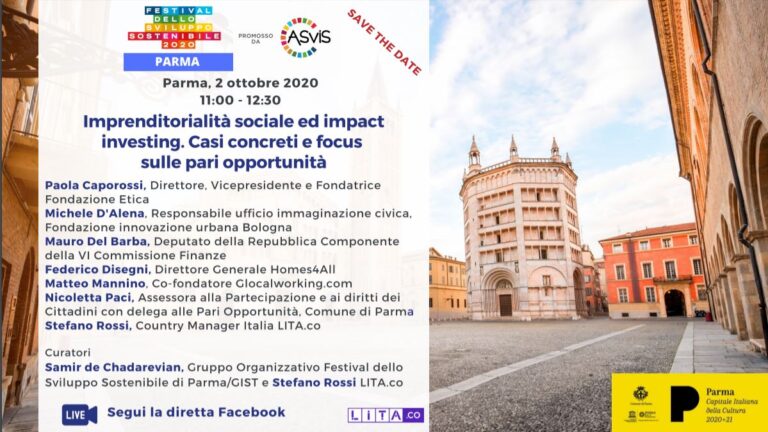When we talk about volunteering, usually, we all think of a traditional type of volunteering, the one for which generous people dedicate time and energy to emergencies and social needs such as migrants, the elderly, the disabled.
But there is also another volunteer, more hidden and less showy: that of those who try to intervene not directly on the single emergency, but on its causes. Too often, in fact, the volunteers have played a substitute role on behalf of the State, effectively ending up exercising a blank delegation on a problem that tends to recur cyclically.
It's just these days the Nobel for economics to a Scottish economist who claims the harmfulness of philanthropic donations to developing countries, which end up drugging their economies without resolving the structural issues.
The new form of volunteering must in no way replace the traditional one, but simply flank her: traditional volunteering, in fact, is essential because every emergency requires, above all, an immediate response.
There is though another step forward than volunteering it needs to do, this too above all cultural. Regard money. For some volunteers it is almost a taboo subject: they don't want to deal with it. Only then, to carry out many of their activities, volunteers need money. And they find themselves at ask for them either from the Municipality (or other Institution) or from the philanthropist on duty. But philanthropists have a queue of people asking for donations, while the public institution has no more money. Or rather, he no longer has as much money as he used to. And not only in Italy.
Therefore, it is urgent to think about new forms of “sustainable” financing” for this new historical phase.
There is another variable which must be taken into account for a complete picture of social policies: the forecasts circulating for the next few years. According to authoritative institutes such as Oxford Economics, the spending on incompressible social needs (water, education, health, etc…) are destined to grow exponentially throughout Europe, particularly in Germany and the United Kingdom.
Since these are incompressible needs, states cannot fail to find a way to provide for it, under penalty of social conflicts which, moreover, would add other costs, as well as undermine social cohesion. This is why right from United Kingdom the search for new and sustainable development and financing models has begun.
The result is what is called Social Impact Innovation. Even in Italy we hear about it, but in terms only of social innovation, and not innovation with a social impact. The difference is not small. Making impactful social policies means addressing not just the single emergency – for example, migrants – in order to deal with it, but making sure that the impact is positive for the entire community.
For this to be possible, innovation – and therefore development – need innovative forms of financingthat go beyond the limits of public and private. The answer lies in another formula, less known than the other, which is the Social Impact Investing.
The term was coined by Rockefeller Foundation and from JP Morgan. The investment banks, in fact, have found themselves solving a problem for their customers: that of diversify investment portfolios characterized by the search for high profits, but for this very reason penalized by a high volatility. They can earn big and fast, but with financial crises like the one in 2008 they can also lose big and just as fast.
Also taking into account the propensity for philanthropy of many investors, the attempt has been to invest a small percentage of those portfolios in targeted projects on incompressible social needs in developing countries. The results were astonishing: while all investment private they gave a minus sign, these always kept a positive sign, moreover in slight and continuous growth. Naturally, the yields of this type of investment are lower and the realization times are longer, but, being uncorrelated, for example, with country risk, they are meeting the satisfaction of many investors.
Over time we realized that that type of investment can also yield returns in countries with developed economies, like the European ones, and for this reason the interest has also started here.
Volunteering should not be suspicious, but attentive and open: these are tools overalli but with simple principles.
First of all, public and private are no longer seen as alternatives, let alone opposites: the private is no better than public. Both because the private do another job than that of the pursuit of the common good; and because even in private they hide not few pockets of corruption.
Therefore, the new innovative finance tools with a social impact bring together multiple actors: the public institution, the private investor, the philanthropist, the non-profit, the valuer. None of them can think of meeting the social needs of the coming years alone and so, to be more effective, they must plan and finance together, with the aim of producing a significant social impact.
In short words: the state makes available a lower sum than the one it has dedicated in the past, let's suppose, to the problem of recovering disused and degraded public spaces and, instead of spending it, it puts guarantee of the money invested by the private individual so that the latter can count on the repayment of the capital even in the event that the project stalls or fails.
Also the philanthropist – which can be, for example, a banking foundation – instead of spending money, it allocates it to guarantee private investment.
The non-profit organizations they carry out the service designed within those spaces, for example for the non self-sufficient elderly or for a space dedicated to children, and the external and independent evaluator evaluates the correct realization of the project.
Where does the return on capital private invested? From the activity carried out: the recovered public good can be dedicated part to a museum run by young jobseekers, partly for a senior center, part to a afterschool, and so on: by charging a low or very low entry ticket, that will, over time, remunerate the invested capital.
The evaluatorand will measure the implementation, correctness and impact of the project, because philanthropy and volunteering must change their mentality on this too: the effectiveness of the donated money must be measured.
Theimpact of course, it is greater than the simple recovery of a disused public asset that was starting to deteriorate: the neighborhood becomes more pleasant, more livable, more lively, richer, safer.
This is an example, but there are many cases of applicability of Social Impact Investing. It's just about getting started.





